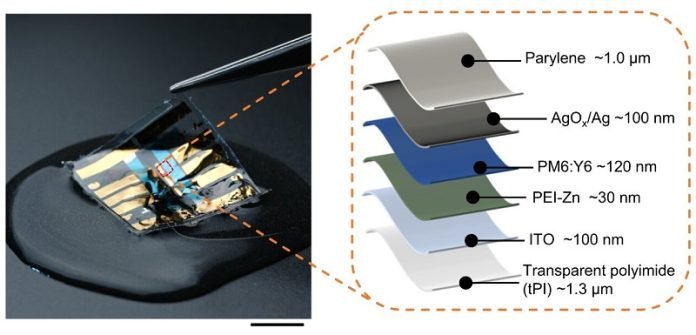
Imagine charging your smartwatch just by wearing your favorite jacket, no matter the weather.
Researchers from the RIKEN Center for Emergent Matter Science and their collaborators have made a significant leap towards this future.
They’ve created a special kind of solar cell film that’s not only flexible enough to bend but can also withstand water.
This means it can be sewn into clothing and remain functional through rain showers and even after being washed in a laundry machine.
Traditional solar cells are rigid and can’t handle water or excessive bending.
This has been a big hurdle for inventing wearables that don’t need constant battery changes, like health monitors woven into your clothes.
The dream has been to make a solar cell that’s both bendy and waterproof without adding bulky layers that make the material stiff.
The breakthrough, detailed in Nature Communications, comes from a new way of constructing the solar cell. Solar cells work by capturing sunlight with an active layer that generates electrical charges.
These charges are then moved to opposite sides of the cell, creating electricity that can power a device. Before, making a solar cell waterproof meant adding extra layers, which made them less flexible.
The team took a different approach by directly adding a silver electrode on top of the active layer, ensuring stronger bonding between the layers.
They then heated the film in air at a warm 85°C (185°F) for 24 hours, a process called thermal annealing.
This careful cooking resulted in a super-thin solar film, only three micrometers thick (thinner than a strand of spider silk), ready for testing.
And the tests were impressive. The film stayed underwater for four hours and kept 89% of its power-making ability.
It survived being stretched by 30% over 300 times underwater, maintaining 96% performance. Most remarkably, it came through a washing machine cycle unscathed — a first for this kind of technology.
Kenjiro Fukuda, a lead researcher, believes this invention opens new doors. It’s not just about making durable solar cells; it’s about paving the way for practical, wearable devices that power themselves.
The team is already looking ahead, aiming to make these solar cells even more resistant to air, light, and stress. The future where your clothes keep your gadgets charged, come rain or shine, is closer than ever.
Source: RIKEN.



